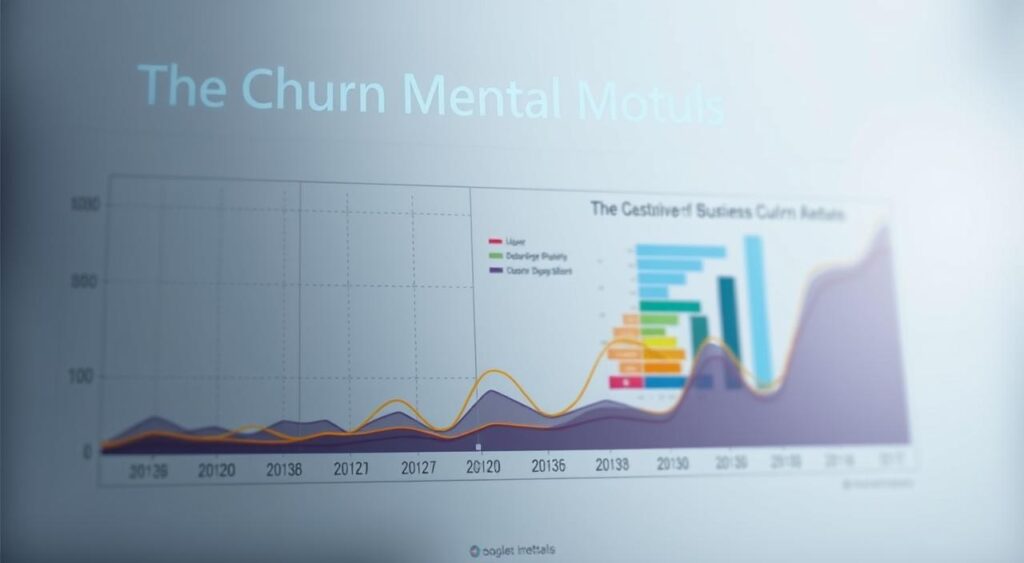Imagine this: Companies lose customers at predictable rates, some up to 20% in tech. Yet, few know how to stop it. Churn isn’t just a number; it’s a silent killer of growth. The Churn Mental Model helps understand why customer churn happens and how to outpace it.
Did you know a 1% rise in customer retention can boost profits by 7%1? This model shows the importance of balancing new clients with keeping existing ones. Replacing lost customers often costs five times more than keeping them1.
Whether it’s tracking a 10% monthly churn rate in subscriptions2 or managing employee attrition at 15% annually1, churn is a universal force.
Without addressing it, even thriving companies hit a “Growth Wall,” like SienarCast’s 6-month plateau at 10% churn2. The question isn’t if churn exists—it’s how to turn it into a strategic advantage.
Key Takeaways
- Churn impacts all industries, from subscriptions to insurance, requiring proactive strategies.
- A 50% reduction in turnover is achievable with employee engagement1.
- Ignoring churn rate trends risks stagnant growth and higher costs1.
- Small retention improvements, like a 1% gain, drive significant profit jumps1.
- Tools like NPS tracking reveal early churn signals2.
Understanding Churn: A Brief Overview
Churn isn’t just about customers leaving. It’s a natural part of every business. From customers to employees, churn management helps businesses stay ahead. By studying attrition rates, companies can turn losses into growth chances.
What is Churn?
Churn is about losing customers, employees, or revenue over time. For example, a SaaS company with a churn rate over 3% loses 30% of customers each year3. Tech products can face up to 15% churn due to usability issues4.
The formula to find this rate is:
(Customers Lost ÷ Starting Customers) × 100
An internet provider with 1,000 customers losing 120 would have a 12% churn rate5.
Why Churn Matters to Your Business
Ignoring churn can hurt profits. Keeping existing customers is cheaper than getting new ones4. High churn rates, like Apple TV+’s 15.6% monthly rate, show service gaps3. Even small improvements can make a big difference: reducing churn by 5% can boost profits by 25-95%4.
- Churn analysis finds problems early, like bad service or pricing
- Low churn rates, like Peloton’s 1.41%, show happy customers3
- High churn rates expose big risks, like a 110% rate causing net losses5
Proactive churn management prevents big problems. Tools like CRM systems track trends. Strategies like HubSpot’s customer happiness programs can recover 33% of at-risk accounts4. Focusing on churn analysis turns losses into chances for improvement.
The Impact of Churn on Customer Retention

Churn isn’t just a number; it’s a threat to keeping customers. When customers leave, they take money and growth with them. Reduce churn by catching problems early. Look for signs like less app use, fewer buys, or more complaints.
These signs show customers are unhappy before it’s too late6.
“Churn is… the slow leak, the constant drip of customers slipping away, of users drifting off to find something new.”
Identifying Churn Triggers
Think of churn triggers as cracks in a dam. Small problems, like bad service or old features, can hurt loyalty. Use these signs to act quickly:
- Track login frequency and feature usage drops
- Monitor negative feedback in surveys or reviews
- Watch for sudden cancellations of subscriptions or orders
Strategies to Reduce Churn
Make customers feel important to keep them. Use personalized messages, loyalty rewards, and quick support. Netflix uses data to suggest content, keeping users interested. Amazon’s Prime offers special perks to keep customers coming back.
Studies show that current customers spend more than new ones6.
So, keeping them happy is worth it.
Try these effective methods:
- Send personalized emails when activity falls
- Give loyalty discounts or rewards
- Run satisfaction surveys to fix issues early
In SaaS, cutting churn by 1% can add hundreds of users to ARR6. For telecom, where churn is 31%7, good billing and loyalty programs help. Every plan starts with knowing what customers need and acting fast.
Measuring Churn Effectively
Tracking churn isn’t just about counting lost customers. It’s about finding patterns to prevent them from leaving. Start by focusing on metrics that show why and when customers leave. Important numbers like customer churn rate and net retention rate help you see where to adjust your strategy.
For example, if your e-commerce business has a 70–80% churn rate8, you’re losing most customers faster than you can get new ones.
Tools like retention curves help you see these trends. They show when engagement starts to drop. Let’s look at what to track and how.
Key Metrics to Track
These metrics help you understand your business better:
- Customer Churn Rate: This shows how many customers leave each month. If you have 4,000 customers and lose 5% monthly, that’s 200 people9.
- Revenue Churn Rate: This measures lost revenue from customers who leave. If you lose $5,000 on a $100,000 MRR, that’s a 5% churn rate8.
- Net Retention Rate: This tells you if revenue grows or shrinks despite churn. SaaS companies aim for below 14% median churn8.
Tools for Monitoring Churn Rates
Advanced tools like churn modeling platforms use AI to forecast at-risk customers. Tools like Qualtrics iQ combine data to predict behavior, letting you act before churn happens9.
A meditation app used retention curves to spot a flattening engagement trend, then redesigned onboarding to reduce churn. Churn prediction software can flag high-risk users, while dashboards track real-time changes.
Pair these with mental models frameworks to decode why customers stay or leave.
Using data with churn prediction tools turns numbers into steps you can take. The right tools let you see patterns others miss, like how a Halloween store’s 40% post-holiday churn9 needs seasonal retention strategies.
Stay ahead of churn by blending metrics with smart tech—your business thrives when you know what to watch for next.
Applying the Churn Mental Model in Business
Turning theory into action, churn management needs practical steps. These steps help turn insights into customer retention wins. By using the Churn Mental Model businesses can make strategies work in real life.

Real-Life Examples of Churn Management
Leading companies show that customer churn can be managed. Spotify cut churn by 15% with personalized recommendations. Slack reduced attrition with better onboarding10.
These successes match data showing 42.2% of Recurly clients lowered churn rates. They focused on recovery tactics10. Gamification, like giving badges for engagement, also works well11.
- Spotify: 15% churn drop through personalization
- Slack: 22% lower churn via onboarding improvements
- Recurly: 72% of at-risk users retained via recovery events10
Building a Customer-Centric Culture
Richard Branson’s idea—“Employees come first”—is important. Teams that care for their staff see 30% lower churn rates11. Create feedback loops to catch issues early.
Avoid treating customers like a cult. Parrish says forcing loyalty can backfire11. Use simple metrics like login frequency drops to spot at-risk customers11.
“Employees come first. If you take care of them, they’ll take care of clients.” — Richard Branson
Balance retention efforts with realistic expectations. Focus on reducing customer effort over creating perfect experiences. Studies show effort reduction drives loyalty better than over-delivering11.
Future Trends in Churn Management
Businesses must keep up with changing customer needs to avoid losing customers. We’ll look at how new tech and strategies will help in keeping customers.
The Role of Technology in Churn Reduction
AI-powered churn prediction tools are changing how companies prevent customer loss. These tools give insights in real-time, spotting at-risk customers quickly. For example, AI can spot changes in spending that might lead to leaving.
By 2025, using AI to watch churn rate will be common. Tools will map customer journeys and tailor retention plans12. This will let teams focus on important talks with clients12.
Adapting to Changing Customer Preferences
Today, customers want smooth digital experiences. If services don’t meet these needs, churn rate can rise. A 5% churn rate can cut LTV by up to 33% in three years13.
To stay ahead, businesses need to mix automation with personal touches. For example, in-app tools are becoming better than emails for keeping in touch. AI makes content more personal, setting companies apart12. Those who don’t use these tools will fall behind12.
Creating a strong churn strategy means using data, tech, and understanding customers. By focusing on churn prediction and being flexible, your team can stay ahead. The future isn’t just about keeping up—it’s about leading the way.


